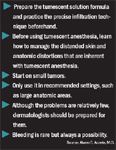- General Dermatology
- Eczema
- Chronic Hand Eczema
- Alopecia
- Aesthetics
- Vitiligo
- COVID-19
- Actinic Keratosis
- Precision Medicine and Biologics
- Rare Disease
- Wound Care
- Rosacea
- Psoriasis
- Psoriatic Arthritis
- Atopic Dermatitis
- Melasma
- NP and PA
- Skin Cancer
- Hidradenitis Suppurativa
- Drug Watch
- Pigmentary Disorders
- Acne
- Pediatric Dermatology
- Practice Management
- Prurigo Nodularis
Article
Tumescent local anesthesia feasible for many skin cancer surgeries
National report - Tumescent local anesthesia is an effective strategy for many skin cancer surgeries, according to Colombian investigators.

"Since the local anesthetic is highly diluted, tumescent local anesthesia is very safe in major skin cancer surgery and also includes many other advantages," says principal investigator Alvaro E. Acosta, M.D. "Pain is minimal, hydrodissection improves the surgical view, and large areas can be anesthetized safely on an outpatient basis."
Dr. Acosta is an associate professor of dermatology at the National University of Colombia in Bogotá, where he is the chief of the department of dermatology and oncology at the National Cancer Institute of Colombia.
With tumescent local anesthesia, the infiltration process involves minimal pain itself, and after its administration, the patient is able to rest calmly through the skin cancer surgery.
Enhanced visualization
An added advantage of tumescent local anesthesia is increased ability to visualize the surgical site, Dr. Acosta says.
"The hydrodissection effect improves the surgical view," he tells Dermatology Times. The increased visualization, as well as the diminished intraoperative bleeding associated with the tumescent approach, allows the dermatologist to visualize the site and allows for atraumatic surgery to be performed and diminishes the risk of nerve damage.
In addition, he stresses that the technique is associated with several other advantages:
Dr. Acosta notes that dermatologists have long used tumescent local anesthesia in liposuction. He first published on its use in reconstructive cancer surgery in 1997.
Good in difficult situations
Dr. Acosta notes that a broad group of candidates can safely undergo tumescent local anesthesia, including patients with hypertension and cardiovascular disease.
In addition, dermatologic surgeons are often concerned about the risks of general anesthesia in those who have large lesions but who also have health problems that may make general anesthesia problematic.
"Patients with cutaneous malignancies located on areas such as the zygomatic arch, where the temporal branch of the facial nerve lies in a superficial level," are also often problematic, he explains. "In this example, the distortion produced by the tumescent anesthesia is advantageous because, due to the tumescent effect, the tumor, as well as the skin that surrounds it, is detached from the aponeurosis where the temporal nerve lies. This means then, that, during surgery, the temporal nerve will be less exposed to damage."
Finally, many patients don't like the prolonged sedation associated with general anesthesia, and others would like to use as few chemicals as possible. The fact that tumescent anesthesia is highly diluted may appeal to such patients and help them to view it as less invasive and aggressive than other anesthesia methods, he says.
Considering contraindications
However, Dr. Acosta stresses that the tumescent approach is not appropriate for all cutaneous malignancies.





